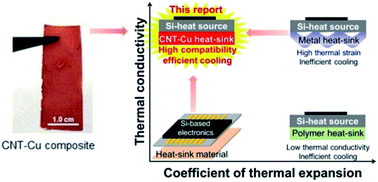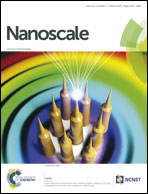Carbon nanotube-copper exhibiting metal-like thermal conductivity and silicon-like thermal expansion for efficient cooling of electronics†
Abstract
Increasing functional complexity and dimensional compactness of electronic devices have led to progressively higher power dissipation, mainly in the form of heat. Overheating of semiconductor-based electronics has been the primary reason for their failure. Such failures originate at the interface of the heat sink (commonly Cu and Al) and the substrate (silicon) due to the large mismatch in thermal expansion coefficients (∼300%) of metals and silicon. Therefore, the effective cooling of such electronics demands a material with both high thermal conductivity and a similar coefficient of thermal expansion (CTE) to silicon. Addressing this demand, we have developed a carbon nanotube–copper (CNT–Cu) composite with high metallic thermal conductivity (395 W m−1 K−1) and a low, silicon-like CTE (5.0 ppm K−1). The thermal conductivity was identical to that of Cu (400 W m−1 K−1) and higher than those of most metals (Ti, Al, Au). Importantly, the CTE mismatch between CNT–Cu and silicon was only ∼10%, meaning an excellent compatibility. The seamless integration of CNTs and Cu was achieved through a unique two-stage electrodeposition approach to create an extensive and continuous interface between the Cu and CNTs. This allowed for thermal contributions from both Cu and CNTs, resulting in high thermal conductivity. Simultaneously, the high volume fraction of CNTs balanced the thermal expansion of Cu, accounting for the low CTE of the CNT–Cu composite. The experimental observations were in good quantitative concurrence with the theoretically described ‘matrix-bubble’ model. Further, we demonstrated identical in-situ thermal strain behaviour of the CNT–Cu composite to Si-based dielectrics, thereby generating the least interfacial thermal strain. This unique combination of properties places CNT–Cu as an isolated spot in an Ashby map of thermal conductivity and CTE. Finally, the CNT–Cu composite exhibited the greatest stability to temperature as indicated by its low thermal distortion parameter (TDP). Thus, this material presents a viable and efficient alternative to existing materials for thermal management in electronics.


 Please wait while we load your content...
Please wait while we load your content...